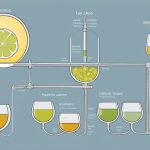Wine tartness is a distinctive quality that can define a wine’s profile and it arises primarily from the acidity present in wine. Acidity is crucial as it contributes to the taste, balance, and overall structure of the wine. It works alongside sweetness, alcohol content, and tannins to create a complex and harmonious flavor. Each type of acid found in wine grapes, such as tartaric, malic, or citric, has a unique impact on the flavor and can influence the perception of tartness.

Various factors during the winemaking process affect the acidity levels, including the grape variety, climate, soil, and fermentation methods. Cooler growing regions often produce grapes with higher acidity, which translates into wine with brighter tartness. The process of aging and storing wine also plays a role; over time, acid can diminish or evolve, changing the tart character of the wine. While tartness is considered a positive quality that contributes to the freshness and longevity of a wine, its balance with other components is essential for creating a pleasant sensory experience.
Key Takeaways
- Acidity is the main contributor to wine’s tartness, affecting its flavor and balance.
- Geographical and winemaking variables impact the levels and types of acid in wine.
- The aging process alters wine’s acidic profile, influencing its tart taste over time.
Table of Contents
What Gives a Wine Tartness? The Role of Acidity in Wine
Acidity is a central component in wine that contributes to its tartness and balance. It is one of the key attributes that can influence a wine’s freshness and longevity.
Understanding Acidity Levels
Acidity in wine refers to the concentration of hydrogen ions present, which directly impacts the wine’s tartness. Generally, wine acidity levels range from 2.5 to 4.5 on the pH scale, with 7 being neutral. Types of acids such as tartaric, malic, and citric are present in wines and contribute to the acidic taste. Wines with higher acidity tend to taste more tart.
Influence of Climate on Acidity
The climate where grapes grow has a significant effect on the levels of acidity in wine. Grapes from cooler regions will often have higher acidity, resulting in wines that are more tart. Warm climates may lead to lower acidity and softer wines. The grape’s acidity is also influenced by soil types and vineyard practices.
Acidity and Wine Balance
A wine’s balance refers to how the different elements like acidity, sweetness, alcohol, and tannins interplay. Acidity can add structure, making the wine feel more crisp and refreshing. When balanced well, the acidity will complement other flavors rather than overpowering them, leading to a rounded and harmonious profile.
The Winemaking Process
The winemaking process involves various steps that significantly influence a wine’s tartness. These steps range from fermentation, which introduces acidity, to specific practices that can adjust the final acidity levels.
Fermentation and Acidity
During fermentation, yeast converts the sugars in grape juice into alcohol, carbon dioxide, and heat. This process also produces acidic compounds, which are crucial to the wine’s tartness. The type of yeast and the fermentation conditions can result in different levels of acidity in the wine.
Malolactic Fermentation
Malolactic fermentation is a second fermentation process in which bacteria convert malic acid into lactic acid. This conversion softens the wine’s acidity, reducing its tartness and creating a more buttery mouthfeel. Not all wines undergo malolactic fermentation, as it depends on the winemaker’s desired wine profile.
Winemaking Techniques and Acidity Control
Winemakers use various techniques to control acidity. One method is acidification, which involves adding acid to the wine before or during fermentation to achieve the desired tartness. Other practices include adjusting fermentation temperature and using specific types of barrels, which can influence the wine’s overall acidity.
Types of Acids in Wine

Wine’s tartness largely comes from four types of acids naturally present in grapes and developed during fermentation.
Tartaric Acid
Tartaric acid is the principal acid in grapes, and it remains stable throughout the winemaking process. It adds to the wine’s backbone, providing a fresh, sharp taste and helping to protect the wine from spoilage.
Malic Acid
Malic acid is another natural acid in grapes, often described as the acid that gives green apples their signature tart flavor. It can be modified through a process called malolactic fermentation, which softens a wine’s taste by converting malic acid into softer, creamier lactic acid.
Citric Acid
Although citric acid is found in small quantities in grapes, it plays a crucial role in the wine’s tartness and freshness. Some winemakers add extra citric acid to balance out a wine or to enhance its sharpness if the grapes aren’t naturally acidic enough.
Lactic Acid
Lactic acid is not typically found in large amounts in grapes. It usually appears in wine after malolactic fermentation, which can transform the sharper malic acid into the smoother and milder lactic acid, often associated with a more buttery flavor profile in some wines.
Varietal Characteristics

The tartness in wines is closely linked to the types of grapes used. Different grape varieties bring their distinct levels of acidity, which contribute to the tart flavor profile of the wine.
White Wines and Acidity
Riesling and Sauvignon Blanc are popular white grape varieties known for their zesty acidity. Riesling grapes, often grown in cooler climates, produce wines with a sharp, crisp tartness. On the other hand, Sauvignon Blanc is recognized for its green apple and citrus flavor notes, which stem from its high acidity levels, imparting a lively tartness to the wines.
Red Wines and Acidity
While red wines typically have less acidity than white wines, varieties like Merlot still exhibit noticeable tartness. The grape’s growing environment greatly affects its acidity; for instance, Merlots from cooler regions can exhibit a more pronounced tart character. Contrastingly, Chardonnay, a white wine grape, can range from buttery to tart depending on how it’s aged and where it’s grown, with cooler climates favoring more tartness.
Geographical Influence
The tartness of wine is significantly shaped by where the grapes are grown. Climate conditions and soil properties in a region can alter the acidity levels in grapes, influencing the wine’s tart flavor.
Climate and Region
Regions with cooler climates tend to produce grapes with higher acidity which translates to greater tartness in wine. These areas have temperature variations between day and night that help preserve grape acidity. For instance, a wine from a cooler region like Chablis in France may exhibit more tartness compared to a wine from a warmer region.
Soil and Terroir
Soil composition also impacts a wine’s acidity, part of what is known as terroir. Grapes grown in certain soils, like those with high limestone content, may yield a more pronounced tartness due to the soil’s effect on the vines’ water retention and heat reflection. The unique combination of soil and climate in a region creates an inimitable terroir, shaping the distinctive tart character of its wine.
Sensory Experience
The sensory experience of tasting wine involves both the sense of taste and the physical sensations in the mouth. When sipping wine, one can detect its tartness, which is a crucial component of the wine’s flavor profile and contributes to the overall tasting experience.
Palate and Mouthfeel
The palate perceives the tartness in wine through a distinct mouthwatering sensation. This is due to the acids in wine, such as tartaric and malic acid, which stimulate the taste buds and glands in the mouth. The mouthfeel also plays a role; the acidity of the wine can lead to a sensation that ranges from smooth and soft to sharp and crisp. This combination of taste and tactile sensation is essential to understanding a wine’s flavor profile.
Tasting Experience
During the tasting experience, individuals assess the wine’s balance between sweet and tart flavors. Acidity adds a fresh zing, making wine taste vibrant rather than flat or one-dimensional. It’s what can make a wine feel lively and bright as opposed to heavy and dull. A well-balanced wine will leave a lasting impression, and the level of tartness can greatly influence that experience.
Wine Aging and Storage
When wine is stored properly, its flavor profile can transform significantly. The acidic components mellow, and new flavors might develop, changing the wine’s tartness.
Aging and Its Effects on Acidity
As wines age, they often undergo a process of flavor development. Acidity is one component that can mellow out during this time. For example, wines with high aging potential are crafted in a way that their tartness, caused mainly by acids like tartaric and malic acid, integrates with other flavors over time. This can make a wine less sharp and more complex.
Oak Aging and Acidity
Oak aging also plays a significant role in altering a wine’s acidity. When wine is aged in oak barrels, it can gain vanilla, toast, and spice notes. These new flavors contribute to a wine’s overall balance, but they can also influence perceived acidity. The process of oak aging allows oxygen to interact with the wine slowly, which can soften the acidic taste and may enhance a wine’s smoothness.
Health and Consuming Wine With Acidity
When it comes to wine’s tartness, it’s interesting to see how its acidity connects with health. People often drink wine for the taste, but there are benefits and considerations to keep in mind regarding its acidity.
Health Benefits
Acidity in wine, primarily coming from its tartness, is not just about flavor. It can influence health too. In general, wines with moderate acidity can contribute to good digestion, and it’s thought that the antioxidants found in wine, like polyphenols, may offer some heart health benefits. They may help protect the lining of the heart’s blood vessels. It’s important to connect this to the type of wine, as red wines typically have higher levels of these substances.
- Digestive Aid: Acidity may help improve digestion by stimulating stomach acids.
- Antioxidants: Wines contain compounds that could assist in preventing heart issues.
Wine in Moderation
Drinking wine with tartness should be done in moderation. While some health benefits are associated with consuming wine, they mostly apply when wine is enjoyed in small amounts. Experts recommend that individuals who drink wine do so with restraint to avoid adverse health effects.
- Recommendations for Men: Up to 2 glasses a day
- Recommendations for Women: Up to 1 glass a day
By following these guidelines, individuals can enjoy the taste and potential health benefits of wine without overdoing it.
Conclusion
Wine’s tartness largely comes from its acidity, which is crucial for the quality of the wine. This acidity gives a wine its characteristically refreshing taste and can affect how a wine feels in one’s mouth. Factors like grape variety, climate, and winemaking practices are key to determining a wine’s acidity levels.
- Grape Variety: Some grapes are naturally more acidic than others.
- Climate: Cooler climates tend to produce grapes with higher acidity.
- Winemaking Practices: Decisions made during the fermentation process can increase or decrease tartness.
When pairing wine with food, acidity can help cleanse the palate, making each bite taste as flavorful as the first. Certain vintages, or years of wine, may have higher acidity due to the specific weather conditions of that year, which greatly affects the grapes’ development. A well-balanced acidity contributes to the overall quality of the wine, potentially making it more enjoyable and suitable for pairing with a wide range of dishes.
Choosing a wine that suits one’s personal taste and the occasion is important. Whether looking for something bold and rich or light and refreshing, wine lovers should consider the level of tartness to find a wine that complements their meal and enhances the experience.
Frequently Asked Questions
Understanding the nuances of wine’s tartness involves exploring the chemistry behind it and the winemaking techniques employed.
What are the main acids responsible for wine’s tartness?
The tartness in wine primarily comes from three types of acid: tartaric, malic, and citric. Tartaric acid is the most prominent, followed by malic acid, which is found in fruit such as apples, and citric acid, commonly associated with citrus fruits.
How does the presence of tannins affect wine’s acidity?
Tannins contribute to the astringency and complexity of wine rather than its acidity. However, they can influence the mouthfeel and perception of tartness in wine.
Which types of wine typically exhibit higher levels of acidity?
Wines like Sauvignon Blanc, Riesling, and Chablis typically display higher acidity levels. These wines are known for their crisp and refreshing quality.
In winemaking, how is acidity manipulated to achieve the desired tartness?
Winemakers can manipulate acidity by choosing when to harvest grapes, using cooler fermentation temperatures, or through the addition of acid during the winemaking process to balance the wine and achieve the desired level of tartness.
What is the role of tartaric acid in contributing to the flavor profile of a wine?
Tartaric acid plays a vital role in maintaining the wine’s chemical stability and color, and it is a key contributor to the wine’s taste profile, providing a distinctly sharp character to the wine.
Can the perception of acidity in wine vary based on the wine’s other characteristics?
Yes, the acidity’s impact can vary based on other wine characteristics, including sweetness, alcohol content, and tannins, which can all alter the perception of tartness in the palate.







